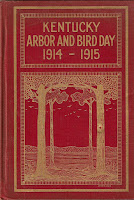What should be taught at Arbor Day?
 Kentucky Arbor and Bird Day, 1914-1915 is a curious little book. It is a guide for teaching Arbor Day and Bird Day, published by the Commonwealth of Kentucky.
Kentucky Arbor and Bird Day, 1914-1915 is a curious little book. It is a guide for teaching Arbor Day and Bird Day, published by the Commonwealth of Kentucky.James B. McCreary, Governor of the Commonwealth, proclaimed in the book's foreword that Arbor Day would be observed in Kentucky schools on Friday, November 6, 1914. Later in the book, it is suggested that Bird Day be observed on the same day.
The book, about 125 pages in all, is an assortment of exhortations to the teacher, essays about trees and birds, inspirational poems, plays for the school children to perform, words and music to half a dozen songs, tree and bird facts, and even some colored illustrations (glued into the book, but apparently part of the orgiinal publication).
The following excerpt is taken from an essay titled "Three Kinds of Planting":
Plant Trees; by all means, Plant Trees. That's number one. But don't forget to
Plant also the Love of Trees. That's number two. For this kind of planting, the best soil is the heart of childhood and of youth. And while you are about it
Plant likewise Knowledge concerning Trees. That's number three. Not necessarily the Forester's technical knowledge; just a comfortable "working knowledge," you know. The leading species and how to distinguish them; how and what kind to select for planting -- or to reject; how to set out a Tree; how to care for and protect it; and so on. Not very recondite knowledge this, and easy to impart -- also easy to take in. And useful? Yes, masters, eminently useful; and if Kentucky is to do its best in trees, indispensable.
Now, of the three plantings above recommended, number one would mean in time a Kentucky adorned throughout its length and breadth with stately trees. Number two would mean a Kentucky of tree-loving, tree-fostering, tree-protecting people. And number three, a Kentucky noted for, and profiting by, its sound judgment in tree matters -- its intelligence in the conservation of trees, and in their planting, care, and protection.
Trees, love of trees, knowledge of trees, these three; and the greatest of these (one ventures to think) is Knowledge. For to know trees is to love them; and to love trees is to plant, care for, protect and conserve them. So the last becomes first; heads the shining list; leads unfailingly to the other two. And indeed, without Knowledge, love would be helpless and planting of little avail. "My people perish" twas said of old, "for lack of knowledge." And as with the people, so with the people's trees. Selah!
(Adapted from Eighth Annual Report of the Newark Shade Tree Commission.)
Quoted from Kentucky Arbor and Bird Day 1914-1915 (pages 31-32), compiled by Mrs. V. O. Gilbert. Published in Frankfort, Kentucky by the State Journal Company for the Commonwealth of Kentucky, no publishing or copyright date given.
Related articles (posted on my other blog):
The Country Boy's Creed
The Farmer's Creed -- and Its Author, Frank I. Mann
Planting a Love for Trees

 "The power to recognize trees at a glance without examining their leaves or flowers or fruit as they are seen, for example, from the car-window during a railroad journey, can only be acquired by studying them as they grow under all possible conditions over wide areas of territory. Such an attainment may not have much practical value, but once acquired it gives to the possessor a good deal of pleasure which is denied to less fortunate travelers."
"The power to recognize trees at a glance without examining their leaves or flowers or fruit as they are seen, for example, from the car-window during a railroad journey, can only be acquired by studying them as they grow under all possible conditions over wide areas of territory. Such an attainment may not have much practical value, but once acquired it gives to the possessor a good deal of pleasure which is denied to less fortunate travelers."
0 comments -- please add yours:
Post a Comment